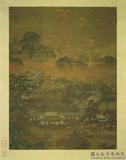明文徵明沈周唐寅仇英便面合裝冊 冊 明唐寅萬山秋色
推薦分享
資源連結
連結到原始資料 (您即將開啟新視窗離開本站)後設資料
- 資料識別:
- 故畫003524N000000005
- 資料類型:
- 類型:繪畫
- 型式:靜態圖像
- 著作者:
- 唐寅
- 主題與關鍵字:
- 秋景 溪澗、湍泉 江河、湖海 雲 高士(士人、隱士) 行旅 楓樹.槭樹 水榭 房舍 橋
- 出版者:
- 數位化執行單位:國立故宮博物院
- 格式:
- 本幅 19.7x52.8公分、全幅 62x62.5公分
- 關聯:
- 故宮書畫錄(卷八),第四冊,頁164&*唐寅(西元一四七0-一五二三年),字子畏,又字伯虎,號六如。天賦多才,生性疏放,狂逸不羈。弘治十一年(一四九八)中南京鄉試解元,後牽連京試賄賂案,被謫為吏,從此絕意宦途,一心窮研詩、書、畫。 山巖亭榭之間,人事往來,雲影繚繞,遂覺千山萬樹,秋色如妝。此幅山石樹木屋宇人物,用筆細緻,無一筆鬆懈,為其盛年功力精至之作,畫上題款字用小篆,在他處亦不多見,唐寅三十歲後學周臣,此圖技法頗盡其精髓。本幅為「文沈唐仇便面合裝」冊第五開。 &* T’ang Yin (style names Tzu-wei and Po-hu; sobriquet Liu-ju) was gifted with many talents, naturally carefree in disposition, as well as unrestrained and untrammeled. In 1498, he was the top candidate in the Nanking provincial examination. Later, however, he was implicated in the capital examination bribery scandal and punished to fill the post of goverment clerk. After this event, he renounced his ambition to be an official and devoted himself to poetry, painting, and calligraphy. Depicted in this album leaf, figures make their way back and forth between the mountains and pavilions. Clouds wind round and round, making one feel deep within a thousand peaks and myriad trees adorned with autumnal colors. The brushwork used for rendering the rocks, trees, buildings, and human figures in this painting is meticulous without a single careless stroke. Thus, this is one work of T’ang Yin’s ultimate achievement from the prime of his life. T’ang Yin wrote an inscription in small seal script on the painting, something he did not often do. After he was 29-years-old, T’ang Yin studied painting under Chou Ch’en (fl. 15th-16th century). In terms of technique, this painting makes abundantly clear the spiritual essence of Chou’s works.
- 管理權:
- 國立故宮博物院
授權聯絡窗口
- 國立故宮博物院圖像授權、出版授權、影音資料授權-申請流程說明
http://www.npm.gov.tw/zh-TW/Article.aspx?sNo=03003061






